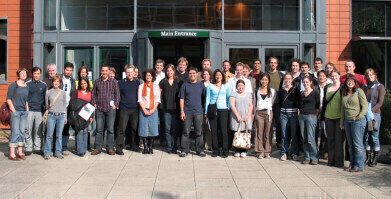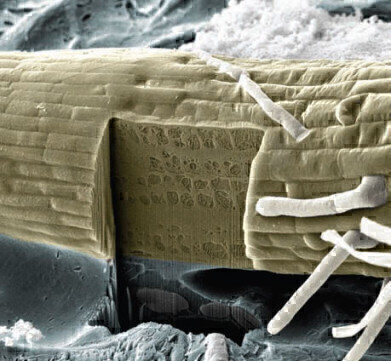News & Views
Systems Biology Takes Root at the Centre for Plant Integrative Biology
Apr 29 2009
The Centre for Plant Integrative Biology at the University of Nottingham is employing the combined skills of mathematicians, computer scientists, engineers and plant biologists to produce a virtual plant root. Using the model higher plant Arabidopsis thaliana, the team will model root growth and development from the sub-cellular to whole organ level. The resulting ‘virtual root’ will be able to simulate
how roots respond to different conditions, providing researchers with a vital tool for addressing problems including food security, effects of climate change, and development of biofuels.
The Centre, based at the Sutton Bonington Campus of the University, is one of six UK Centres for Integrative Systems Biology funded by the BBSRC and EPSRC. The £9.2 million, five year project began in 2007, and is applying a ‘systems approach’ to its research. Experimentalists provide laboratory results to mathematical and computational modellers, who use them to produce models. In turn, the models give rise to
further research questions for the laboratory to address, resulting in an iterative cycle of model refinement and data production. As the Centre’s Director, Prof Charlie Hodgman, put it: “CPIB aims to be a prime example of how an interdisciplinary team can use systems biology to tackle a plant science question.”
Efforts towards a model plant root are divided into four themes, or strands. The first strand seeks to understand how cells elongate in the root as it emerges from the seed and grows. In order to understand the mechanical behaviour of root cells, the CPIB biophysicist has developed techniques for surveying the pressure within the cells of a living root, which is similar to that of the average car tyre. The Finite Element
modeller is using techniques normally employed in engineering composite materials such as aeroplane wings to simulate the cell wall of an elongating root cell as a fibrereinforced viscous material.
Plant growth, as in animals, is regulated by hormones. Mapping where different plant hormones act and their effects within different cells in the root is an important aspect of the CPIB project. The second research strand focuses on how hormones regulate cell division. Several research associates are using a technique known as targeted misexpression to reveal which of the five different tissues within the root the different hormones are acting upon.
Strand Three examines lateral root development. Understanding how lateral roots develop is important because they enable the root system to elaborate its architecture and secure resources such as water and nutrients. Recent work by CPIB’s Marie Curie Research Fellow
and colleagues is identifying the genes regulating lateral root emergence [1]. This work is being used to build mathematical models of the regulatory network for lateral root emergence.
Strand Four of the programme integrates the models at different physical scales across the first three strands. This requires the coupling together of models of cell growth, hormone transport and genetic regulation. One of the CPIB mathematicians is using multiscale asymptotic methods to study a cell-based model of the movement of the plant hormone auxin in the elongating root. Meanwhile a computer scientist is using P-systems, a computational modelling framework inspired by the structure and functioning of biological cells, to develop tissue-levels model of plant hormone transport and signalling.
In the emerging field of multiscale modelling, there is no standard way or framework of representing multiscale models. The development of compatible data standards is crucial to long-term understanding of root growth and architecture and CPIB is actively involved in discussions with the other leading Integrative Biology groups on this.
The Centre also undertakes a variety of outreach activities. The third Mathematics in the Plant Sciences Study Group will take place in January 2010. This group gives plant scientists the opportunity to present biological questions to an assembled body of mathematicians, computer scientists and engineers, who then spend the next four days modelling the biological problem. These meetings have resulted in new
collaborations, publications (including a patent) and grant applications, and are an invaluable means of bridging the gaps between experimental and theoretical disciplines.
CPIB also runs an annual summer school designed to provide an introduction to mathematical modelling for biologists. Aimed primarily at PhD students and postdoctoral researchers, these four day courses combine lectures driven by examples from biology with hands-on experience of applying modelling techniques.
One of the 2008 participants felt that the summer school had helped them make their first moves into interdisciplinary research: "I feel I could communicate better with mathematicians now ... I wouldn’t have known where to start before this course!".
Further information is available from the CPIB website: www.cpib.ac.uk or email susie@cpib.ac.uk
Digital Edition
Lab Asia 31.2 April 2024
April 2024
In This Edition Chromatography Articles - Approaches to troubleshooting an SPE method for the analysis of oligonucleotides (pt i) - High-precision liquid flow processes demand full fluidic c...
View all digital editions
Events
Apr 22 2024 Marrakech, Morroco
Making Pharmaceuticals Exhibition & Conference
Apr 23 2024 Coventry, UK
Apr 23 2024 Kintex, South Korea
Apr 23 2024 Seoul, South Korea
Apr 24 2024 Jakarta, Indonesia









.jpg)









